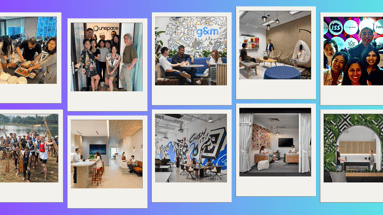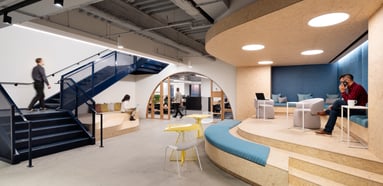The Imperative of Workplace Experience Design (WXD)
.jpg?width=1600&height=933&name=The%20Imperative%20of%20Workplace%20Experience%20Design%20(WXD).jpg)
As we consider the opportunities for innovation within the Asia commercial real estate market, one thing becomes ever more apparent: the necessity to place the Unispace Group mindset of human-centered, experiential design at the forefront.
Workplace Experience Design (WXD) and some trends within this practice, can help illustrate the opportunities of this approach.
A holistic view of Workplace Experience Design
Workplace Experience Design (WXD) isn't just about making a space aesthetically appealing. At its core, it is about understanding employees with the same depth and complexity as we understand our customers. It prioritizes equity-based, human-centered designs that foster trust, loyalty, and a sense of belonging. You can define workplace experience as an individual's spectrum of lived experiences and performance within a work context and their subsequent perceptions of the organization.
Inherent to this definition are multifaceted elements that shape a worker's experience—ranging from their relationship with tasks and colleagues to their interplay with the technological apparatus, the physical environment, and even their personal growth trajectory. Notably, it is vital for businesses to emphasize a worker's sense of belonging and growth, ensuring a workplace ecosystem that celebrates diversity, equity, and inclusivity.
Transition from conventional workspaces to dynamic environments
Gone are the days when employees were confined to their cubicles from nine to five. Yet, the role of physical spaces in shaping work experiences and, by extension, organizational culture, loyalty, and talent retention cannot be understated. So, what transformative opportunities does WXD bring to the table?
- Adaptable spaces: The dynamism of work today necessitates environments that evolve beyond static physical confines. With the rise of remote work and gig economies, organizational leaders are presented with the challenge of nurturing cohesive, engaged teams that might not even share a physical workspace. Herein, adaptability becomes paramount.
- Optimized digital toolkit: Beyond mere collaboration, cutting-edge technological tools and platforms empower employees to function seamlessly regardless of their physical location. In this era, optimizing and integrating these digital apparatuses is not a luxury but a necessity.
- Safety: A safe environment—both physically and mentally—transcends mere regulatory compliance. It impacts employee well-being, morale, and long-term health. An environment steeped in safety considerations positively impacts workers, customers, and the broader organizational fabric.
- Dedicated spaces: Access to well-defined spaces, be it for focused work, team collaboration, well-being, or casual interactions, can significantly uplift employee engagement and performance.
- Flexibility: Granting workers the autonomy to determine their work timings and locations is not just a perk. It has tangible ramifications on productivity, satisfaction, and stress levels.
- User Experience (UX): The integration of UX in workplace design ensures spaces that cater to both the professional and personal nuances of employees. Harnessing technology for things like activity-based working or using data analytics to optimize operational elements embodies this principle.
The way forward
The trajectory of Workplace Experience Design (WXD) is undoubtedly an influential determinant of an employee's daily experiences. To navigate the tumultuous terrains of modern business operations, especially during times of crisis, organizations must champion WXD. By crafting workspaces that are adaptive, safe, and flexible, businesses are not merely investing in infrastructure but in their most valuable asset: their people. The rewards for such investment are manifold, from heightened employee morale and productivity to an organizational culture that attracts and retains the best talent. In the final analysis, the meticulous design of the workplace isn't just a strategic move—it's a business imperative for the future of work.
About Tim Larson, Unispace Managing Director & Chief Creative Officer &, Asia

|
Tim Larson, Chief Creative Officer & Unispace Managing Director, Asia. Based in our Singapore studio, Tim is the Chief Creative Officer and Unispace Managing Director, Asia. He has been a leading innovator in the field of designing emerging experiences, and interaction in architectural environments for more than 25 years. Previously Design Principal, Downstream, our experience design agency, he grew the business through pioneering new approaches in corporate interiors, retail stores, sports and entertainment venues, among other space types. Connect with Tim on LinkedIn |


